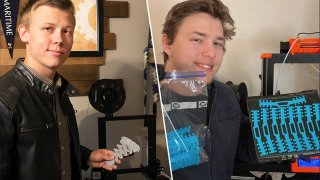
Two community college students are using their newly obtained engineering skills to create a product that can provide relief to the ears of essential workers required to wear face masks.
Dillon Johnson, 24, and Nicholas Snyder, 20, are both in Cuyamaca College's engineering program and wanted to use the skills they developed to ease the pressure on the ears of those required to wear face masks while performing their essential duties on the frontlines of the fight against coronavirus.
"I hear stories of overwhelmed hospitals and my heart breaks," Johnson said. "I imagine it being normal for a medical worker to go an entire shift without smiling and that isn’t right."
Each student is using his at-home 3D printer to produce the "ear saver," a plastic band that looks similar to a comb and hoops around the back of the neck to relieve pressure on the ears. By simply moving the straps from behind the ears to behind the head, you can eliminate the discomfort, Snyder said.
The product has gained popularity across the country as more and more essential workers are mandated to wear face masks. Designs can be found easily online and those with at-home 3D printers are jumping in to help, though Johnson said he drew his own design.
Snyder was inspired to print ear savers for his mom, a local nurse, and her coworkers after seeing photos on Instagram of the discomfort face mask straps were causing medical workers.
"One photograph in particular captured my attention where the backside of this individual's ears had actually begun bleeding from the prolonged use of face masks," Snyder said.
U.S. & World
News from around the country and around the globe
When a friend asked if he could print some for other essential workers, Snyder expanded his efforts. He has since revised his template after getting feedback from the people wearing them.
"I am currently on the second revision making them smaller and simpler, which not only holds the mask in place better and is less bulky, but takes less time to produce," Snyder said.
Combined, Johnson and Snyder have created about 350 ear savers using different designs. The products have been donated to health care workers at UC San Diego Medical Center, Kaiser Permanente and Sharp Grossmont Hospital, to name a few -- and the students don't have plans to stop.
Johnson said his appreciation for health care workers after several stints in the hospital due to a bout of testicular cancer and appendicitis inspired him to produce something for medical staff. His sister told him about ear savers and he's since been making dozens of devices a day.
"In the darkest hours of my darkest days, the medical workers helped me, my family, and my friends. Now is the time that I can return the favor," Johnson said.
The device can be used by health care workers, those in the food service industry, grocery store workers and others who have to wear masks for long stretches.
The chair of Cuyamaca's engineering program, Miriam Graf Simpson, said both students have used exactly what they are taught at the college to improve lives.
"We try to teach our engineering students... that engineering is a way to not just improve a project, but to improve lives and communities,” Simpson said.
Johnson is transferring to San Diego State in the fall to study mechanical engineering. He hopes to be a toymaker, which he calls the "perfect combination of being able to put smiles on peoples faces and hands-on work."
Snyder also hopes to study mechanical engineering once he finishes Cuyamaca's program. He is interested in the manufacturing industry but his passion lies in internal combustion engines.



